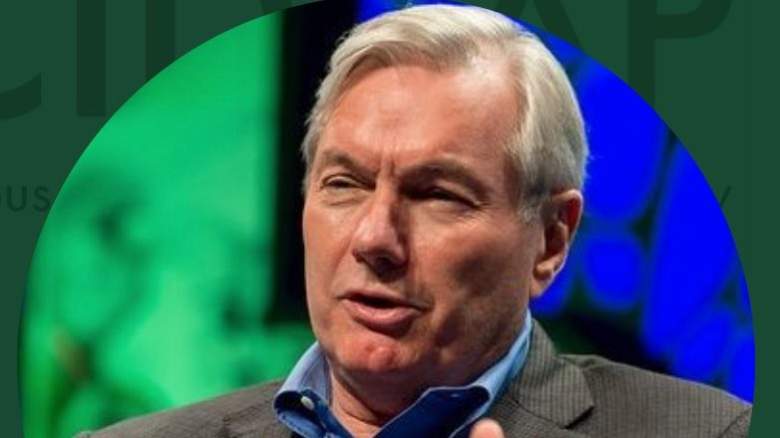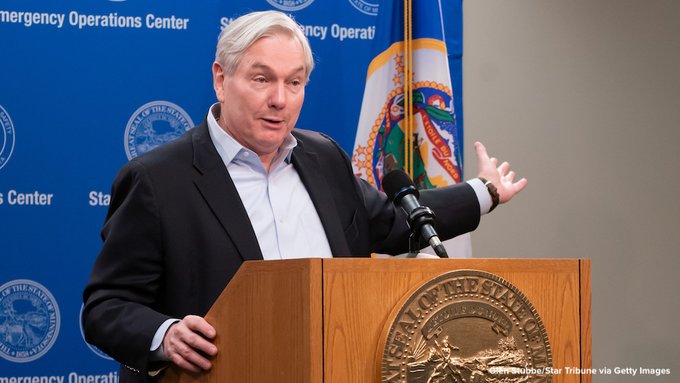
Twitter Dr. Michael Osterholm
Dr. Michael Osterholm is the director of the Center for Infectious Disease Research and Policy (CIDRAP) at the University of Minnesota. He was tapped this week by President-Elect Joe Biden to be part of the incoming administration’s COVID-19 task force.
Osterholm’s experience in epidemiology is expansive and goes back to the 1970s. According to CIDRAP, Osterholm is a Regents Professor, McKnight Presidential Endowed Chair in Public Health, and is a member of the National Academy of Medicine (NAM). In 2008, “he was appointed to the World Economic Forum Working Group on Pandemics,” and in 2017 Osterholm wrote the New York Times best-selling, Deadliest Enemy: Our War Against Killer Germs, in which he laid out a 9-point plan to combat pandemics that he dubbed the “Battle Plan for Survival.”
CIDRAP reported Osterholm said, “If we know how to greatly reduce the risk of these public health problems and we don’t, then we become an accomplice to the morbidity and mortality they cause. We need a new generation of public health experts who can effectively address these issues in ways we’re not addressing now.”
Here is what you need to know:
1. Osterholm Said in 2017 He Didn’t Think the Trump Administration Had Infectious Disease or Public Health ‘At the Top of Its Agenda’ but He Believes Pandemics are Avoidable

GettyUS President Donald Trump listens as Vice President Mike Pence speaks about the COVID-19 (coronavirus) alongside members of the Coronavirus Task Force in the Brady Press Briefing Room at the White House in Washington, DC, March 9, 2020.
In a 2017 interview with the University of Minnesota School of Public Health, Osterholm said he considers himself a disease detective, but it’s not enough just to understand the way pandemics spread and how that spread can be prevented. It also requires preventative measures to be implemented at the government level.
Three years ago, Osterholm told the University of Minnesota School of Public Health:
Being a disease detective is very gratifying. But it’s also very sobering at the same time. These are real people dying from diseases that in many instances could have and should have been prevented. This work allows you to solve mysteries and implement positive change for large segments of the world’s population…
We are facing so many challenges right now — from a potential looming influenza pandemic, to the inevitable tsunami impact of antibiotic resistance, to bioterrorism. And we have no clear international governance structure for how we are going to deal with these issues…And early messaging from our current administration suggests that issues related to public health and infectious diseases may not be top priorities on its agenda.
2. Osterholm Said ‘This Is the Virus Versus Us’ But Americans Aren’t Looking at It That Way
Osterholm told Yahoo Finance Wednesday that Americans need to hear the story of what’s really happening with the coronavirus pandemic, saying:
And so I think that the message is how do we get through this? We need FDR moments right now, we need fireside chats, we need somebody to tell America, this is what in the hell is gonna happen.
And this is what we’ve got to do about it in a way that they believe it, they understand it, they feel it, and they see that somebody’s trying to lead them — and that can be anybody — but I believe that the transition team surely is placing the president elect in particular to help guide us, and his message has been very clear.
Osterholm told Yahoo Finance, “We are entering this period I call COVID hell,” which he attributes to the huge increase in cases since Labor Day from about 23,000 cases, he said, to 130 to 140,000 new cases per day in the U.S. more recently, and he says those numbers will continue to rise as epidemiologists predicted would happen as the nation goes into the winter months.
Osterholm said:
…We’ve been predicting this. It’s a combination of pandemic fatigue — people just being tired of trying to, you know, avoid the public and the places that put you at increased risk; pandemic anger — where up to a third of the U.S. population that does not believe this pandemic is real to begin with, so why adhere to any kind of public health recommendations? And then we just have indoor error — we have a situation where we’re going indoors right now, we know that virus concentrations build up inside and transmissions much more there so we have to tell the story of what’s coming.
…So just understand everyone on this screen will know a COVID-related event either in yourself or your family or your colleagues in the days ahead if you haven’t had it happen already, it’s going to happen. There won’t be any blue or red states anymore. There won’t be blue or red counties, it will all be COVID color.
3. Osterholm Said He Thinks a Nationwide Lockdown for 4 to 6 Weeks Would Greatly Help Get the Pandemic Under Control & The Federal Government Has a ‘Pool of Money’ to Get the Nation Through
Osterholm says there is a lack of understanding about what lockdown really means and what is necessary to get the pandemic under control, but he told Yahoo Finance there is a “pool of money” that could keep Americans and businesses afloat while a federal lockdown is implemented for four to six weeks, pointing out that national lockdowns are how some other countries got the virus under control.
Osterholm told Yahoo Finance:
We talk about the pain and suffering of the virus , about the pain and suffering to the economy and what it does…. We have a big pool of money out there that we could borrow at the historic low interest rates by the federal government. We could pay for a package right now to cover all of the wages lost wages for individual workers for losses to small companies to medium-sized companies or city states county governments. We can do all of that. If we did that then we could lock down for four to six weeks and if we did that, we could drive the numbers down like they’ve done in Asia, like they did in New Zealand and Australia, and then we could really watch ourselves cruising into the vaccine availability in the first and second quarter of next year. And bringing back the economy long before that.
While studies on the effects of various types of lockdowns estimate they likely prevented millions of infections worldwide, according to the Gavi Vaccine Alliance, “Like many things associated with COVID-19, the ultimate value of lockdowns is still uncertain but will depend on the choices and actions of people around the world. And like any medicine, the benefits of lockdown may ultimately be shown to depend on timing, dose, and duration.”
4. Osterholm Is Enthusiastic About the Pfizer Vaccine Which Is Said to Be More Than 90% Effective But He Says There Is Still A Lot Unknown About How Effective It Will Be for Everyone

GettyA woman wears a facemask as she walks by the Pfizer world headquarters in New York on November 9, 2020. – Pfizer stock surged higher on November 9, 2020 prior to the opening of Wall Street trading after the company announced its vaccine is “90 percent effective” against Covid-19 infections. The news cheered markets worldwide, especially as coronavirus cases are spiking, forcing millions of people back into lockdown.
Pfizer and its partner BioNTech announced on November 9 that the companies have developed a COVID-19 vaccine that has proven to be more than 90% effective, but according to Osterholm, there are still many outstanding questions and there are still “dark” months ahead before that or any vaccine will be available to most people.
He told Minnesota Public Radio:
First of all, it is good news that this vaccine was found to be 90% effective. But how good that news is yet to be determined. What I mean by that is that what we don’t know — was that preventing 90% of illnesses characterized by fever, cough and upset stomachs, or was that 90% protection against severe disease, hospitalization and even deaths?
And none of those data were available to us to assess just how well the vaccine worked against severe disease. That’s what we’re trying to really limit. And we know from the influenza world that we use vaccines for those who are most at risk of serious illness, older populations, people with increased body mass indexes, but [these groups of people are] also where the vaccines don’t work as well.
According to Osterholm, even if the Pfizer vaccine turns out to be approved and available sometime next year, “We have some very dark months ahead of us,” because there is still an uncertain amount of time to navigate without a vaccine as cases of COVID-19 continue to break records.
He told MPR, “So that’s great news to have [a vaccine]. It will surely be important in the long run of how we deal with this. But right now, the immediate challenge we have of the next several months is without a vaccine tool.”
5. Osterholm Is 1 of 13 COVID-19 Task-Force Members Under President-Elect Biden
According to Stat News, the thirteen members of President-Elect Biden’s COVID-19 Task Force are the “who’s who of former government health officials, academics, and major figures in medicine.”
Biden said in a statement that Osterholm and the other scientists and experts on the task force team will help “shape [his] approach” to combatting the pandemic.
The President-Elect said in a November 9 statement published in Stat News, “Dealing with the coronavirus pandemic is one of the most important battles our administration will face, and I will be informed by science and by experts. The advisory board will help shape my approach to managing the surge in reported infections; ensuring vaccines are safe, effective, and distributed efficiently, equitably, and free; and protecting at-risk populations.”
On being asked to serve on the new administration’s task force, Osterholm said in a Tweet, “Honored to be a part of this. We will do our very best to help out however we can.”
He also spoke to MPR about being part of Biden’s Task Force Team, saying:
I can’t comment right now on what the internal workings will be, that still all being worked out. But they really have an outstanding team of experts in the area of administration and public policy. So I’m confident that the advisory task force will in fact be very active, and I look forward to working with them in terms of developing what I call realistic approaches to dealing with this pandemic.
READ NEXT: Woman Accused of Killing Her 2 Babies Said Their ‘Organs Could Be Worth A Lot of Money’
